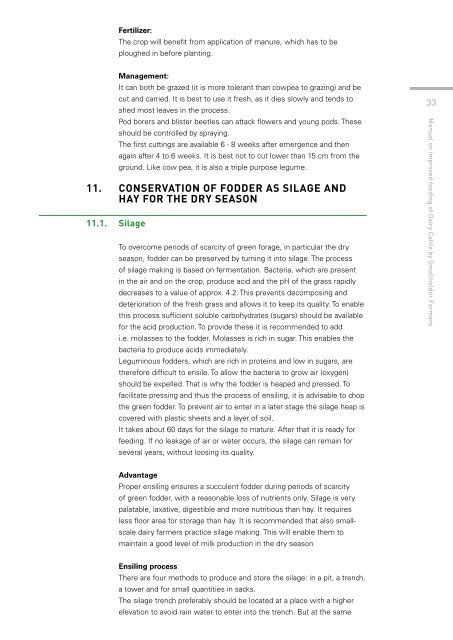MANUAL ON IMPROVED FEEDING OF DAIRY CATTLE BY ... - Gart
MANUAL ON IMPROVED FEEDING OF DAIRY CATTLE BY ... - Gart
MANUAL ON IMPROVED FEEDING OF DAIRY CATTLE BY ... - Gart
You also want an ePaper? Increase the reach of your titles
YUMPU automatically turns print PDFs into web optimized ePapers that Google loves.
Fertilizer:<br />
The crop will benefit from application of manure, which has to be<br />
ploughed in before planting.<br />
Management:<br />
It can both be grazed (it is more tolerant than cowpea to grazing) and be<br />
cut and carried. It is best to use it fresh, as it dies slowly and tends to<br />
shed most leaves in the process.<br />
Pod borers and blister beetles can attack flowers and young pods. These<br />
should be controlled by spraying.<br />
The first cuttings are available 6 - 8 weeks after emergence and then<br />
again after 4 to 6 weeks. It is best not to cut lower than 15 cm from the<br />
ground. Like cow pea, it is also a triple purpose legume.<br />
11. C<strong>ON</strong>SERVATI<strong>ON</strong> <strong>OF</strong> FODDER AS SILAGE AND<br />
HAY FOR THE DRY SEAS<strong>ON</strong><br />
11.1. Silage<br />
To overcome periods of scarcity of green forage, in particular the dry<br />
season, fodder can be preserved by turning it into silage. The process<br />
of silage making is based on fermentation. Bacteria, which are present<br />
in the air and on the crop, produce acid and the pH of the grass rapidly<br />
decreases to a value of approx. 4.2. This prevents decomposing and<br />
deterioration of the fresh grass and allows it to keep its quality. To enable<br />
this process sufficient soluble carbohydrates (sugars) should be available<br />
for the acid production. To provide these it is recommended to add<br />
i.e. molasses to the fodder. Molasses is rich in sugar. This enables the<br />
bacteria to produce acids immediately.<br />
Leguminous fodders, which are rich in proteins and low in sugars, are<br />
therefore difficult to ensile. To allow the bacteria to grow air (oxygen)<br />
should be expelled. That is why the fodder is heaped and pressed. To<br />
facilitate pressing and thus the process of ensiling, it is advisable to chop<br />
the green fodder. To prevent air to enter in a later stage the silage heap is<br />
covered with plastic sheets and a layer of soil.<br />
It takes about 60 days for the silage to mature. After that it is ready for<br />
feeding. If no leakage of air or water occurs, the silage can remain for<br />
several years, without loosing its quality.<br />
Advantage<br />
Proper ensiling ensures a succulent fodder during periods of scarcity<br />
of green fodder, with a reasonable loss of nutrients only. Silage is very<br />
palatable, laxative, digestible and more nutritious than hay. It requires<br />
less floor area for storage than hay. It is recommended that also smallscale<br />
dairy farmers practice silage making. This will enable them to<br />
maintain a good level of milk production in the dry season<br />
Ensiling process<br />
There are four methods to produce and store the silage: in a pit, a trench,<br />
a tower and for small quantities in sacks.<br />
The silage trench preferably should be located at a place with a higher<br />
elevation to avoid rain water to enter into the trench. But at the same<br />
33<br />
Manual on improved feeding of Dairy Cattle by Smallholder Farmers


